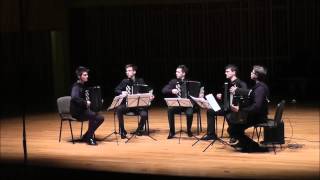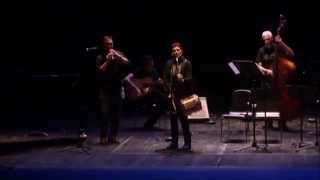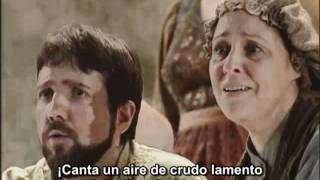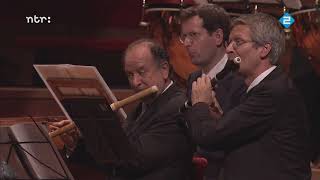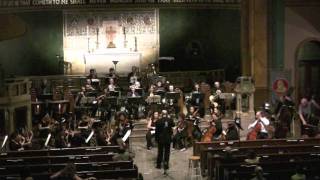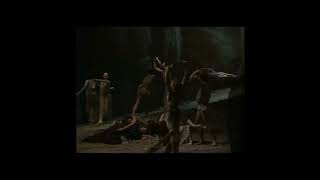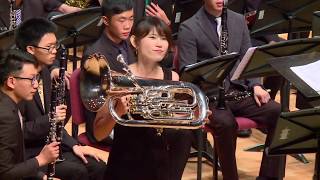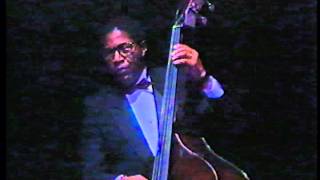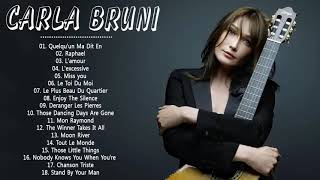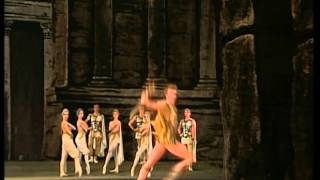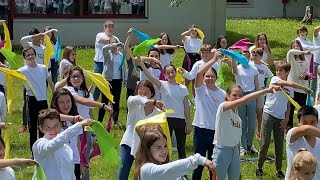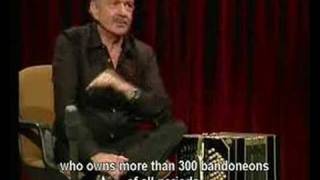On September 23 at 6:49 a.m. Autumn begins.
Recommended music videos for initiation to classical music
Antonio Vivaldi (1678-1741) was an Italian priest, violinist and composer known as the red priest (“il prete rosso”). He was born in Venice and as a child he learned to play the violin with his father; At the age of 15 he entered the Seminary and once ordained a priest, he could barely attend to his religious obligations due to his health problems; So he was appointed violin teacher in an orphanage where he taught theory and instrument classes. At the age of 40 he was appointed Chapel Master in Mantua where he wrote his famous Four Seasons . From there he moved to Milan , then to Rome ; later, again to Venice and finally, to Vienna where he would die. Throughout his life he composed almost 800 works, of which half were concerts, 40 operas, 60 religious works and numerous sonatas.
The Concerto is a musical form written for one or more solo instruments accompanied by an instrumental ensemble. It was Vivaldi who established the fundamental bases of its structure with three movements ( I Fast-II Slow-III Fast ) and presented as a dialogue between the soloists and the instrumental ensemble.
The Four Seasons are a set of four concerts, to which at its premiere an explanatory pamphlet similar to what we understand as Programmatic Music was attached.
Julia Fischer as a soloist, accompanied by the Academy of St Martin in the Fields, offers us today the Autumn : I (0´5´´) ALLEGRO “Celebrates the rustic, with dances and songs, the happy harvest and the joyful pleasure of the Bacchus liquor ; They abuse it so much that their joy ends in sleep. II (4´45´´) ADAGIO MOLTO. “Everyone must play dances and songs. The temperate air gives pleasure and well-being, and the season invites so many to the beautiful joy of a very sweet dream.”-. III (7´14´´) ALLEGRO. “At dawn the hunter goes out to hunt with horns, guns and dogs. The beast flees, and they track it. Already surprised and exhausted by the great noise of guns and dogs; wounded, tired of fleeing and defeated, overwhelmed, she dies.”
Modest Mussorgsky (1839-1881) was a Russian composer who strongly defended and practiced the objectives of the group of The Five ( César Cui, Milij Balakirev, Modest Mussorgsky, Nikolai Rimsky-Korsakov and Alexandre Borodin ). His mother, Yulia Ivanovna, a professional pianist, introduced him to the study of the piano at the age of six; At the age of 13 he entered the Military Academy of Officers of the Imperial Guard , while the following year he published his first composition, a polka ; Around this time he met Balakirev from whom he received composition classes and information about what would become the group of The Five ; At the age of 19 he abandoned his military career to be able to dedicate himself entirely to composition. He died at the age of 42 after a series of epileptic seizures.
Scherzo means "joke" in Italian and is the name given to certain works of music or to some movements of a larger composition such as a sonata or symphony . The word scherzando is sometimes placed in musical notation to indicate that a passage should be played in a playful or humorous manner. The scherzo developed from the minuet and gradually replaced it in the third (or sometimes second) movement of the sonata, string quartet, symphony and similar works. It traditionally retains the 3/4 time signature and ternary form of the minuet, but is considerably faster and more upbeat in nature. Composers also began to compose scherzi as independent pieces, as in the present case.
Scherzo in B Flat Major . It seems that this Mussorgsky Scherzo was originally written as an independent piano piece, and later orchestrated, by Mili Balakirev. On this occasion, however, we present a version for accordion quintet offered by Piotr Zarzyka, Szymon Lipiński, Jan Bielak, Piotr Ostrowski and Jakub Stefaniak .
Jose Ignazio Ansorena Miner (Donostia, 1953), also known by the nicknames Mixki, Mirri and Piter , is a Gipuzkoan musician, txistulari, clown and showman. Born into a family passionate about Basque music , he had as a teacher his grandfather, Isidro Ansorena , a famous txistulari teacher, with whom he completed his txistu and drum studies at the Superior Conservatory of Donostia , among other musical fields. He also has a degree in Philosophy and Letters from the EUTG school of the University of Deusto in Donostia , specializing in Romance Philology. Winner of important Txistu composition and interpretation competitions, he has been a teacher of this instrument and director of the Donostia Superior Conservatory for several years.
Anamari is a Rondó written by José Ignacio Ansorena for quartet of txistu and tambourine, dulzaina, double bass and guitar and today offered by Jasone Akizu – Txistu, Martin Ariztimuño – Dulzaina, Txubio Fdez. de Jauregui – Double bass and Alvaro García – Guitar
Giuseppe Verdi (1813-1901) was an Italian composer; He wrote 28 operas considered a bridge from bel canto to verismo. He was born in Le Roncole near Busetto; As a child he belonged to the Church choir where he received organ lessons and at the age of ten his parents enrolled him in the Busetto Music School , where he received the unconditional support of the patron Antonio Berezzi . Supported by Berezzi , at the age of 19 he moved to Milan where he continued his studies, after which he returned to Busetto as a music teacher and where he married Berezzi 's daughter. In his youth he sympathized with the popular movements that demanded the unity of an Italy divided by different European dynasties. To the point that they chanted “Viva Verdi” with the double meaning of Viva V ittorio E manuele R e D ' I talia.
The Va Pensiero chorus that we can see today belongs to the third act of the opera Nabucco , for many critics his masterpiece; It was precisely this chorus that was sung by the Italian patriots eager for the unity and sovereignty of Italy dominated by the Austrian Empire , identifying with the exile of the Hebrews in the opera Nabucco .
Riccardo Muti (1941), is an Italian conductor who for 19 years has been musical director of the La Scala opera house in Milan ; good connoisseur, therefore, of the lyrical and operatic repertoire. Together with Claudio Abbado, he is the benchmark for Italian conductors of his generation and has worked with the best orchestras in the world. In September 2010, Riccardo Muti became music director of the Chicago Symphony Orchestra and in the same year was named Musician of the Year by Musical America .
Recommended classical music videos
Jean-Philippe Rameau (1683-1764) was a French composer, harpsichordist and musical theorist, highly influential in the Baroque era, replacing Jean-Baptiste Lully as the dominant composer of French opera. Rameau 's lyrical work constitutes the majority of his musical contribution and marks the apogee of the French Baroque with his best-known work, the opera-ballet Les Indes galantes . Despite everything, his lyrical works were forgotten until the mid- 20th century as they benefited from the movement of rediscovery of early music; his works for harpsichord, however, were always present. Rameau is generally considered the most important French musician before the 19th century ; He died in 1764 at the age of 81.
Naïs is an opera in three acts with music by Jean-Philippe Rameau and a French libretto by Louis de Cahusac , the fourth collaboration between the two. The plot refers to the god Neptune in love with the sea nymph Naïs , but who encounters two rivals for Naïs 's affections, who are the Corinthian chief Télénus and the leader of the Isthmian shepherds, Asterion . The work bears the subtitle Opéra pour La Paix , which refers to the fact that Rameau composed the opera on the occasion of the Treaty of Aachen , at the end of the War of the Austrian Succession . Its original title was Le triomphe de la paix , but criticism of the terms of the treaty led to a change in the title. The opera takes the form of a heroic pastoral .
Today we offer a selection of the work with the soprano Katherine Watson , the tenor Samuel Boden and the Frankfurt Radio Symphony Orchestra conducted by the Parisian maestro Emmanuelle Haïm.
Edvard Grieg (1843-1907) was a Norwegian composer and pianist, considered one of the main representatives of musical romanticism. His mother, Gesine , was his first piano teacher; Later, she met the legendary Norwegian violinist Ole Bull , a family friend and her mother's brother-in-law. Grieg adapted many themes and songs from his country's folklore, thus contributing to creating a Norwegian national identity, just as Jean Sibelius did in Finland or Antonín Dvořák in Bohemia . His most important works are: the Piano Concerto in A minor , the intimate Lyrical Pieces (for piano), the Holberg Suite (for string orchestra) and, especially, Peer Gynt, incidental music that he wrote at the request of the writer Henrik Ibsen for his eponymous drama
In Autumn ( In autumn), op. 11, is a concert overture written by Edvard Grieg in 1865. The opening Andante begins with chords played by the orchestra contrasting with a sunny woodwind theme. The tension slowly builds to an Allegro section in D minor in sonata form (exposition-development-reexposition) . The orchestra takes up the main theme taken from a song titled " Autumn Storm ". After the main theme, we hear a secondary theme. The development brings the return of previous themes through a series of restless modulations. After a slower section for horn and strings, the recapitulation brings the return of the main themes. The overture concludes with a triumphant reprise of the opening woodwind theme.
Richard Wagner (1813-1883) was a German composer, conductor, poet, essayist, playwright and musical theorist of Romanticism ; Controversial character for his anti-Semitic ideas and writings such as “Judaism in Music” in which he rants against the musical relationship of Jews with music. In the beginning, his works followed the romantic tradition; but later he transformed musical thought with the idea of the "total work of art" (Gesamtkunstwerk). His capacity for philosophy, literature, music, performing arts, painting and sculpture is transferred to his operas conceived as an exponent of “total art.” With these principles he had the Bayreuther Festspielhaus theater built to be able to perform his own operas, of which in addition to being the author of the music, he was the author of the libretto and the scenery.
Tannhäuser is Wagner 's fifth opera written in three acts with his own music and libretto, based on two German legends; the libretto was written between 1842 and 1843 and the music between 1843 and 1845. Wagner mainly used two stories that appear in the work of Ludwig Bechstein : one of them is the legend of the knight Tannhäuser and the other is the so-called Der Sängerkrieg auf der Wartburg . The main themes of the opera are the struggle between sacred and profane love, and redemption through love, a dominant theme in much of Wagner 's work.
From the Metropolitan in New York , today we offer its full performance with the participation, among others, of Eva Marton, Tatiana Troyanos and Richard Cassily conducted by the American master James Levine .
Anthony Barfield is an American trombonist and composer, whose works have been performed in the USA, Europe and Asia , with commissions from organizations such as the New York Philharmonic and the Lincoln Center for the Performing Arts ; Furthermore, his works have deserved to be performed by orchestras such as the Toronto Symphony , the Seattle Symphony and the Kansas City Symphony . As a former trombonist, he has performed at such venues as Carnegie Hall, Avery Fisher Hall, Dizzy's Coca Cola Club, Alice Tully Hall, and the Kennedy Center . Anthony has degrees in trombone performance from the Juilliard School and the Manhattan School of Music and is a professor at the Boston Conservatory at Berklee .
The Euphonium is a brass instrument that plays the role of baritone-tenor in Wind Orchestras or Music Bands ; It is also known as Euphonio (“sweet sound”), which highlights the character of its own sound to take charge of the singing parts that correspond to the indicated tessitura. The role that the cello plays in an orchestra is played by the euphonium in the Music Band .
Today we present the Concerto for Euphonium and Brass Band, Heritage , by Anthony Barfield structured in three Movements: I (0´35¨¨) BUILDING THE PYRAMIDS .-. II (9´46´´) THE NILE .-. III (17'12'') PHARAOH THUTMOSIS III. The concert is performed by soloist Li Jiaye accompanied by the Chenggong High School Alumni Music Band conducted by teacher Chen Gengyu .
Recommended music videos for all tastes
Autumn leaves is a popular song and jazz standard composed by Joseph Kosma in 1945 with original lyrics by J acques Prévert in French (original French title: "Les Feuilles mortes"), and later by Johnny Mercer in English.
Kenny Barron (1943) is an American jazz pianist. He is one of the leading post bop pianists, influenced primarily by Tommy Flanagan and Wynton Kelly , but also by Thelonious Monk, Art Tatum and McCoy Tyner . He is the younger brother of tenor saxophonist Bill Barron , with whom he made his recording debut, and is known for his lyrical and flexible style. He rose to fame when he played piano in Dizzy Gillespie 's quartet in the 1960s; Since then he has worked with hundreds of leading musicians. He has been nominated nine times for the Grammy Awards and for the American Jazz Hall of Fame and was designated a " Jazz Master" by The National Endowment for the Arts in 2010.
Lana Del Rey (1985) is an American singer, songwriter, model and producer. His music stands out for its stylized quality, its retro style, its themes of tragic romance, glamor and melancholy and its references to the US pop culture of the 1950s and 1960s. His career began performing in clubs in New York at the age of 18, although success would take six more years; It happened to him when he was 26 years old and it came with Video Games . From then on she began to be appreciated and thus her Summertime Sadness was among the top ten on the Billboard Hot 100 . Del Rey has received many awards, including 2 Brit Awards , 2 MTV Europe Music Awards , a Satellite Award and 9 GAFFA Awards. She has also been nominated for 5 Grammy Awards and 1 Golden Globe .
Scorpions is a German hard rock and heavy metal band founded in Hannover in 1965. Throughout their more than fifty-year career they have received numerous awards and decorations, which makes them the most successful rock band in Germany and Europe. Continental Europe . In 2011, the German press estimated that the group's sales reached 160 million records around the world and during the official presentation of the 2009 Echo Awards, it was mentioned that they had given, up to that point, more than 5,000 concerts. live in more than eighty countries. Additionally, as of 2015, his albums had been certified with more than thirty-five platinum records and more than one hundred gold records .
Carla Bruni (1967) is a former Italian model, singer-songwriter and French nationalized actress; She is the third wife of former French President Nicolas Sarkozy . His father, Alberto Bruni Tedeschi (1915-1996), was a businessman and opera composer, and his mother, Marisa Borini (1930), an actress and pianist. In 1975, his family settled in France for fear of kidnappings by the Italian Red Brigades . At a very young age Carla learned to play the piano and later the guitar. During her years as "First Lady", Carla engaged charitably in the humanitarian field, especially in the fight against AIDS . On December 1, 2008, she became the global ambassador of mothers and children against the epidemic at the global fund against AIDS and tuberculosis.
Recommended peculiar videos
Jules Massenet (1842 - 1912) was a French Romantic composer known mainly for his operas, which were very popular during the late 19th and early 20th centuries. Born in Montaud , when he was eleven years old his family moved to live in Paris so that he could study at the Conservatory where he would be a student of Ambroise Thomas . He obtained a first prize for piano in 1859 and in 1863 he won the Grand Prix of Rome thanks to his cantata David Rizzio ; In 1878 he was appointed professor of composition at the Paris Conservatory . Massenet has left behind an essentially lyrical work (twenty-five operas); but he also composed ballets, oratorios and cantatas, orchestral works and about two hundred songs, as well as some piano works.
Cigale is a divertimento - ballet in two acts by Jules Massenet , which was first performed at the Opéra-Comique in Paris on February 4, 1904. The story is inspired by the fable The Grasshopper and the Ant , but is totally different . In this case, the grasshopper is a cicada and the ant is only known as " La Pauvrette " (the poor thing). La Pauvrette , after being welcomed, fed, and feasted by La Cigale , is rude and heartless when the situation is reversed. Cigale is left to die in the snow at the end of the ballet.
Today we offer it in the version of the Malandain Ballet Biarritz choreographic center.
Aram Khachaturian (1903-1978) was an Armenian composer under the Soviet regime. At the age of 22 he began to write his first works for piano and chamber music; later orchestral music, theater and film music (more than 40 works between both genres), as well as ballet music in which the Spartacus ballet and the Gayane ballet are notable, to which the well-known saber dance belongs. He had important disagreements with the Party , being denounced for his “ anti-people music ”, although after Stalin 's death in 1953, he was widely recognized. His music is clear, agile and vibrant, and Armenian popular music, to which he always felt attracted, can be felt in his works; In Armenia he is considered its main composer.
Spartacus ("Спартак", Spartak, in Russian) is a ballet in three acts and ten scenes based on Raffaello Giovagnoli 's novel about the life of Spartacus , composed by Aram Jachaturian ; narrates the exploits of Spartacus , the leader of a slave revolt against the Roman Republic , known as the Third Servile War , taking liberties typical of the aforementioned novel, far from documented historical facts. It premiered on December 27, 19562 with modest success because the choreography abandoned the traditional and academic use of pointe in classical ballet. Spartacus , however, won the Lenin Prize for the Arts in 1959. Today, it remains one of Khachaturian 's best-known compositions and is a regular in the repertoire of Russian companies.
The Idiots . Extracted from his album " N'attendons pas", "Les Imbéciles" is a piece written to mock the tabloid press and in particular the image they choose to represent it, which is often false. “It's written in the magazines with stupid ink.” Vianney sings loud and clear on this upbeat track. This song with a light pen but sprinkled with an embarrassing reality, tells what some magazines like to publish so that people buy. "I never wanted to be seen bigger, more beautiful, whiter than I really am." “We also denounce this taking of freedom over the lives of people with notable notoriety, as if once known, everything was allowed. “(Extracted from RFM. Notocias)
This video is offered to us by the Hummingbird Choir made up of 200 students from the Saint Michel Garikoitz School in Kanbo (Basque Country in France) prepared and conducted by teacher Nelly Guilhemsans .
Ástor Piazzolla (1921–1992) was born in Mar de Plata , Argentina; At three years old he moved with his family to New York where his father bought him a bandoneon. At the age of thirteen he contacted Carlos Gardel and the secrets of tango. Upon his return to Argentina , he received Ginastera classes for six years and was part of different groups, from where his innovations were considered the murder of tango. In Paris , however, he contacted Nadia Boulanger who made him believe in the possible conjunction of tango with classical music. He returned to Buenos Aires with such activity that in 1973 he suffered a heart attack; Despite what he continued with his activity until 1990, in Paris , he suffered a thrombosis that he would not be able to overcome.
The Bandoneón is a bellows wind musical instrument, widely used in Argentina and Uruguay , due to the connection of this instrument with the tango , but also with other genres such as the chamamé, the chacarera, the zamba, the chimarrita, or chamarrita and even with Creole waltzes and, of course, with milongas . It was initially designed in Germany as an evolution of earlier loose reed instruments. It is said that its use was initially as a portable organ to play religious music; When it arrived in the Río de la Plata with the help of sailors and immigrants, it was adopted by musicians of the time and that is how it collaborated in the formation of the particular sound of the River Plate tango , becoming a true symbol of it.
Recommended music videos for children
Various Wikipedia articles have been used to write these texts.
The texts of Videomusicalis are written in Basque, Spanish and English.






